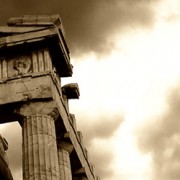Cultural Shift – Part 3; Implications For Western Christianity
[dropcap3]A[/dropcap3]s I’ve studied church history, I think it no stretch to conclude that local churches, over the last 2 millennia, have experienced an average attendance of about 75 adults. Enter, 20th century American Christianity. Or, as I like to call it, Consumeranity.
The average church size in America at present hovers at a little more than 180 adult members, roughly 2.5x larger than historical averages. While nearly 60% of American churches are 100 or less, and around 90% are under 400; more than half of all churchgoers in America attend a church of 400 or more adults.(1) Most congregations are small but most people are apart of large congregations. Such large [Consumeranity] congregations skew the numbers, and [unfortunately] this abnormality is normal for the majority of American Christians.
This anomaly is a relatively recent phenomena (the last 50 years or less), and I believe that the cultural shift taking place in America today will – in the next generation – bring the church back to normal in terms of congregational size and makeup. But what happens when abnormal, which has become normal, reverts back to true normal?
As a result of this shift, some will feel real pain. Many (especially the “movers and shakers” of mega-church evangelicalism) will fight against it. We tend to oppose change, as change is painful. But change is an essential part of life. Alistair Begg once said, “Where there’s life, there’s change. You want no change, live in a cemetery. [There’s no change there], accept for decay.” Therefore, if the church is to experience vitality and life, it will be faced with regular change, or it will decay.
What then does normal Christianity look like in the context of 21st century America? I think it looks like church has for 2,000 years. The gatherings of believers are smaller in size, community oriented, or people-group centered fellowships. For lack of a better word, they are tribal. This being the case, I’m not necessarily sure that multi-cultural, multi-ethnic churches are the norm. That’s not to say that there are not beautiful things that take place in such settings, they’re just not the norm.
Frontline missions has sought for generations to establish self-replicating, indigenous church planting movements. But in our own backyard we constantly seek for an American (or western) multiculturalism within the local body. Please don’t misunderstand, I’m not advocating segregation, only setting forth for consideration the idea that congregations have an established cultural identity from which they worship and express Christian love and character in a way that is relevant to the cultural makeup of the gathered believers.
What then does it practically look like? In all honesty it is quite hard to say, as I have no rhyme or reason for my belief, other than a hunch. I do however think that over the next 30 years the larger congregations in America will fracture along tribal fault-lines as the charismatic executive leaders move on. The churches will become multifarious. They would therefore do well to be proactive in their planning now, if they are to have influence then. I suggest that the best thing the larger traditional church can do is not to scrap it all in favor of a “home church movement” (as one home church movement leader once exhorted me to do) or fight against the shift to prop up the establishment, but to embrace the reality of a smaller community church model by taking what I believe is an Antioch approach.
 The Church of Antioch was the first thriving “uttermost parts” church mentioned in the book of Acts. It was the first Gentile church, and the first at which the followers of Christ were referred to as “Christians.” Little is said in the book of Acts about the makeup of the Antioch church, but my gut tells me that it was a fairly large fellowship with multiple meeting places throughout the region. They were one church, composed of many congregations, superintend by a plurality of overseers (I have purposefully chosen not to use “plurality of elders,” as it means something more than what I’m saying here). The core leadership of Antioch consisted of five apostolic, teaching leaders; Barnabas, Simeon, Lucius, Manaen, Saul (Paul). Antioch thrived for several centuries and was known as a charitable, missional and evangelical church.
The Church of Antioch was the first thriving “uttermost parts” church mentioned in the book of Acts. It was the first Gentile church, and the first at which the followers of Christ were referred to as “Christians.” Little is said in the book of Acts about the makeup of the Antioch church, but my gut tells me that it was a fairly large fellowship with multiple meeting places throughout the region. They were one church, composed of many congregations, superintend by a plurality of overseers (I have purposefully chosen not to use “plurality of elders,” as it means something more than what I’m saying here). The core leadership of Antioch consisted of five apostolic, teaching leaders; Barnabas, Simeon, Lucius, Manaen, Saul (Paul). Antioch thrived for several centuries and was known as a charitable, missional and evangelical church.
As large western churches navigate the current cultural shift, and more and more church planters step forth to birth new works; I propose (as possible first steps) that they/we maintain established church structures to raise up a multiplicity of lay pastors to oversee small community fellowships throughout a city, county or region. Furthermore, churches ought to establish an apostolic core of leadership dedicated to discipleship, for equipping an ever increasing population of overseeing pastors and missionaries.
Ideally, for our fellowship (Calvary Escondido), I’d love to see us get to a point where we have 30+ lay pastors, overseeing small gatherings (under 75) in homes, community centers and other well-suited venues throughout our city and the surrounding region. I would expect we would maintain the structure we currently have for regular corporate worship gatherings as well as a central meeting place for equipping and training. Such a body incorporates the strengths of smaller fellowships (self-care of benevolence, discipline, counsel and other pastoral care needs) as well as the accountability and enabling resources of a larger congregation.
I am quite sure that I’ve overlooked several blind-spots in my consideration of where ecclesiology is headed in 21st century western culture, but as I’m certain it is experiencing a course correction, I want to be at least hypothesizing what that may look like. At the end of the day, I know one thing for sure… God builds his church, I tend to be just “along for the ride.”
[divider_line]




